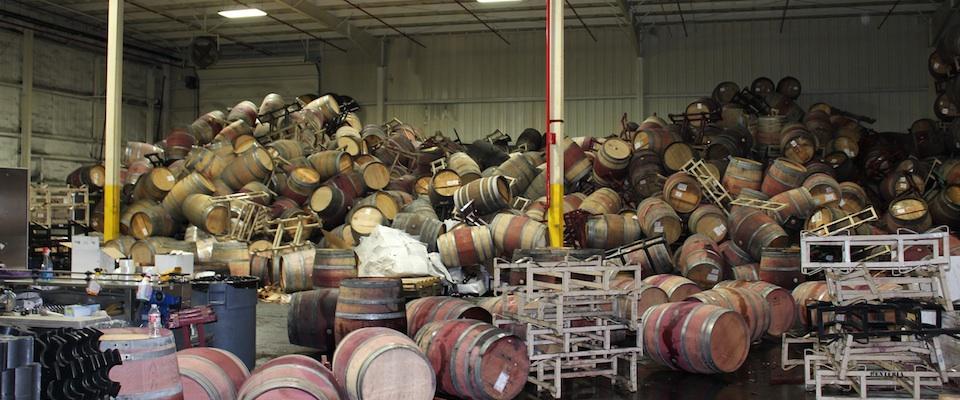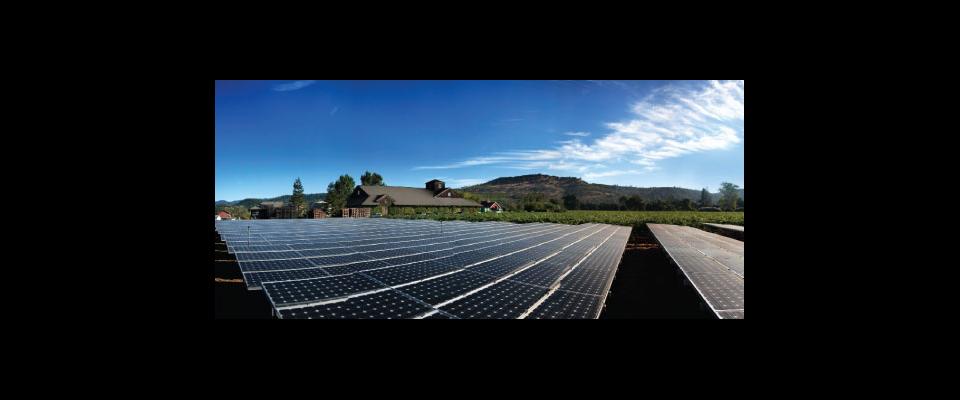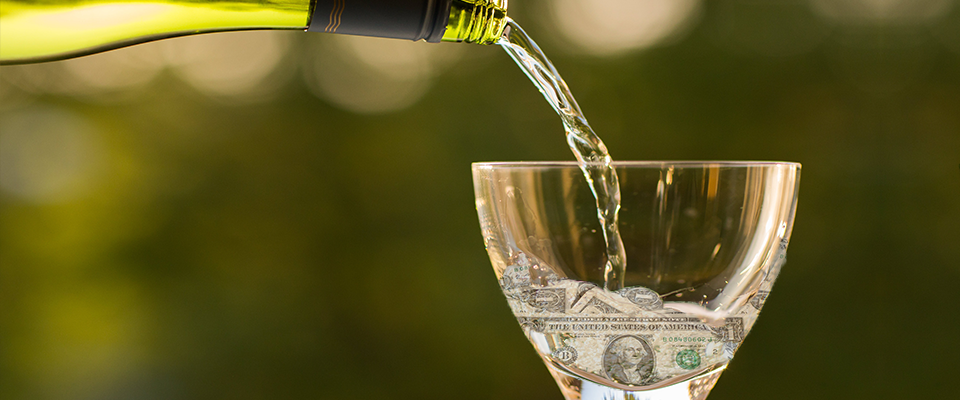A forklift operator at Wild Horse Winery near Paso Robles was maneuvering between barrel rows in the wine cellar when suddenly the ground started to shake. The 18-foot-high stacks swayed above her and then collapsed, burying her in an avalanche of 600-pound barrels. It took rescuers over an hour to reach her, after carefully draining and removing barrels one by one.
The woman escaped the 2003 San Simeon Earthquake with only a broken rib. And the Paso Robles wine industry escaped without a single fatality despite numerous barrel collapses at area wineries during the Magnitude 6.6 quake. They got lucky—as did wineries near the Magnitude 6.0 South Napa Earthquake last month, where wine was lost but where timing probably saved lives.
“Earthquakes that happen in the middle of the night are the best kind, when people are all snuggled up in their beds,” says seismic engineer and earthquake risk consultant Joshua Marrow. Had it occurred in the daytime when barrel rooms were filled with workers, he says, there would almost certainly have been fatalities—and had it struck a week later during the bustling harvest, things likely would have been even worse.
Earthquakes and wine, it turns out, are a natural pairing; the rolling hills and rich soil that characterize California’s world-class grape-growing regions are mostly the result of eons of seismic activity. Marrow, who received his master’s degree in civil engineering from UC Berkeley in 2000, has studied the clash of these California titans for 17 years, specifically the seismic performance of wine barrel stacks. After a big earthquake hits wine country (there have been three since his graduation) Marrow is there—collecting data, collaborating with seismic experts, and recommending changes that he believes would make wine-barrel stacks safer.
For the next few months, Marrow will be working with a team of UC Berkeley undergraduate business students to gather information on wineries affected by the South Napa quake, including wine loss, recovery time, and successful seismic safety practices.
The challenge is getting the industry to listen.

Marrow began his research in 1998 as an undergrad at Cal Poly-San Luis Obispo, when a Kendall-Jackson Winery architect asked the engineering department to investigate the seismic safety of its wine barrels. No one had studied the problem before, so Marrow decided to make it his final project. He discovered that under only moderate shaking, the two-barrel racks used by most wineries would “crab walk” off the ends of the barrels, causing the stacks to fall. In contrast, the less commonly used four-barrel racks withstood heavy shaking.
In 2000, while pursuing his master’s at Berkeley, he invited members of the wine industry and media to Berkeley’s Richmond Field Station to demonstrate his research. Using industry-standard two-barrel metal racks, he stacked a column of wine barrels 18-feet high atop a large earthquake simulator called a shake table. With just a little shaking, the entire stack came crashing down.
Wine barrels can hold the equivalent of 25 cases of wine, worth up to $30,000 or more. Fallen barrels mean lost wine, money, and potentially lives.
“It really shocked ‘em,” Marrow recalls. “Made a lot of believers out of those wineries.”
Just a few months later, nature helped Marrow’s case when the Magnitude 5 Yountville Earthquake struck about 10 miles north of Napa.
“It was phenomenal,” Marrow says, “because we saw exactly what we saw on the shake table. It was just an absolute perfect replica on a larger scale.”
One of those impressed by Marrow’s—and nature’s—demonstration was Bob Torres, senior vice president of operations at Trinchero Family Estates in Napa. Following the Yountville quake, he instituted safety changes at Trinchero based on Marrow’s recommendations, such as lowering their barrel stack height from six to five barrels, and moving stacks away from walls where falling barrels can cause structural damage. At Trinchero’s newest winery in St. Helena, Torres has abandoned the two-barrel racks altogether in favor of an interlocking rack system that stacks only four barrels high.
Torres says he believes those changes helped Trinchero Family Estates avoid major damage from last month’s quake.
Others were hit hard. At least 120 wineries have reported earthquake damage totaling $48 million, a figure that is likely to rise, according to Patsy McGaughy of the Napa Valley Vintners Association. The most significant damage reported was barrel collapse.
Marrow, now director of structural engineering at Partner Engineering and Science, Inc., arrived in Napa the day after the earthquake as part of a team of seismic investigators for the non-profit Earthquake Engineering Research Institute (EERI). He visited numerous facilities, and in winery after winery, what he saw matched Yountville in 2000 and San Simeon in 2003: failed racks, toppled barrels, and liquid money flowing into the sewers.
In one instance, Marrow visited two wineries within eyesight of one another, both just a mile from the fault. The first stored nearly 10,000 barrels on four-barrel racks. The second stored around 3,000 on two-barrel racks. The first lost only two barrels. The second lost over 1,000. Says Marrow, “That’s about the simplest case study you can get.”
Why are wineries so slow to put changes in place? For smaller wineries running on lean margins, Marrow acknowledges, it comes down to dollars. New four-barrel racks are expensive, require bigger forklifts, and often require remodeling the barrel rooms.
“You get pests, floods, bad harvests, fires—there are so many things they have to worry about. Earthquakes are pretty low on their list.”
At B.R. Cohn Winery, which lost 3 to 4 percent of its wine in last month’s quake, winemaker Tom Montgomery contends that the upgrade may simply be out of their price range. “We’re looking into it,” he says, “but it just may be cost prohibitive.”
Marrow and others argue that when an earthquake strikes, the safety changes may prove their worth. Earthquake insurance rarely, if ever, covers wine barrels, so when a collapse occurs, the losses are shouldered entirely by the wineries. As Silver Oak Winery CEO David Duncan told the Associated Press, “I tell (wineries) it’s not as big an investment as having your barrels fall and crack open.”
Barrel-rack manufacturer Topco began converting old two-barrel racks into four-barrel racks in 2006, saving wineries nearly a third of the cost of buying new ones. Owner Diana Ourston says that her company always sees a surge in interest in four-barrel racks immediately following earthquakes, but soon after, “people get complacent and stick to what they’ve got.”
Wineries can avoid making changes because barrel stacks are unregulated. “Building code has no application here,” Marrow says. “And OSHA doesn’t really dictate earthquake safety. The barrels fall in this weird little hole—no one really deals with it.”
Marrow says he hopes cumbersome regulations can be avoided, but that means convincing wineries that change is in their best interest. After analyzing the data he collected last month in Napa, he plans to write articles for trade publications and technical journals and give face-to-face presentations at wine industry professionals’ seminars.
“The wineries are good people, resilient people—they work really hard,” says Marrow. “They have to deal with a lot of risks in their business. You get pests, floods, bad harvests, fires—there are so many things they have to worry about. Earthquakes are pretty low on their list.”
Low, that is, until they strike.
Whether or not the industry will be prepared when the next big one comes remains to be seen. “I think we’re going to make a bigger dent this time,” Marrow says. “I really do.”




















